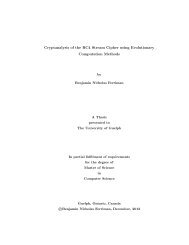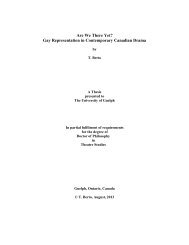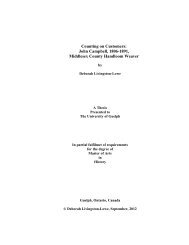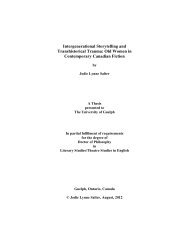THESIS - ROC CH ... - FINAL - resubmission.pdf - University of Guelph
THESIS - ROC CH ... - FINAL - resubmission.pdf - University of Guelph
THESIS - ROC CH ... - FINAL - resubmission.pdf - University of Guelph
You also want an ePaper? Increase the reach of your titles
YUMPU automatically turns print PDFs into web optimized ePapers that Google loves.
6.3.8 STATISTICAL ANALYSIS<br />
Statistical analysis <strong>of</strong> reported data was performed as described in Section 4.3.9.<br />
6.4 RESULTS AND DISCUSSION<br />
6.4.1 EXTRUSION OBSERVATIONS<br />
Extrusion conditions with the addition <strong>of</strong> the cellulose fibers remained very similar to the<br />
process as described in Section 4.0. However, the addition <strong>of</strong> cellulose created complications<br />
mainly due to high hydrophilicity and the self-interacting nature <strong>of</strong> the biopolymer. These<br />
problems were seen during mixing, and throughout the extrusion stages. During mixing, a<br />
programmable peristaltic pump was used to continually dose liquid fractions (water and glycerol)<br />
<strong>of</strong> the formulation into the dry SPI powder. With the addition <strong>of</strong> cellulose fibers into the liquid<br />
fraction, the viscosity dramatically increased impeding the pumping process. As shown in Figure<br />
6.1, changing the fiber concentration from 0.5 to 1% w/w SMF/SPI also changed the texture <strong>of</strong><br />
the solution towards a gel-like state. At 3% w/w SMF/SPI, the texture reflects a semi-solid state<br />
unable to be controllably mixed with powdered SPI. The selected maximum loading <strong>of</strong> 2.5%<br />
w/w SMF/SPI as tested was the limit at which the viscosity <strong>of</strong> the solution was low enough,<br />
suitable for controlled dosing. Additional water could have been used to increase cellulose<br />
concentration, but this would require an additional drying step which might confound previous<br />
findings for film formation.<br />
Another complication arose during compounding and extrusion steps. From the<br />
compounding stage, flakes <strong>of</strong> material were observed to separate from the extruded protein<br />
strands (Figure 6.2b). Depending on the SMF loading, the flakes emerged from the extruder<br />
68

















